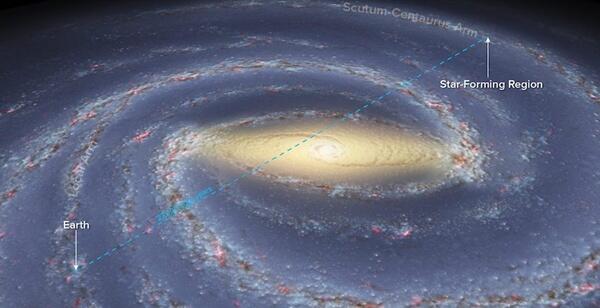We cannot see the Milky Way like we do other galaxies, and that’s because we live inside of it. Although we can peer along its edge while embedded in its disk, we cannot see what it looks like face-on. This is really annoying to astronomers, and akin to a cartographer who wants to make a map of their neighborhood, but is stuck in their house.
In a study published today in Science, a team of researchers directly measured the distance to a star-forming region on the far side of the Milky Way, shattering the previous record for a direct distance measurement within our galaxy. According to the study’s lead author, Alberto Sanna of the Max-Planck Institute for Radio Astronomy (MPIfr), “This means that, using the VLBA, we now can accurately map the whole extent of our galaxy.”
Previous attempts to observe and accurately map the opposite side of the Milky Way have mainly failed because of interloping interstellar dust in the galactic plane, which blocks optical light from reaching us. But, unlike optical light, radio waves can pass unimpeded through the interstellar dust.
For this study, the researchers used the National Science Foundation’s Very Long Baseline Array (VLBA) to take observations in radio wavelengths. The VLBA is not just one telescope, but instead 10 identical 82-foot (25 meters) radio antennas scattered across North America, Hawaii, and the Caribbean. When linked together, these antennas form a massive interferometer with a nearly 5,000-mile (8,000 kilometer) baseline, giving the VLBA enough resolving power to spot a baseball on the Moon.
Between 2014 and 2015, the team used VLBA to take radio observations of a high-mass star-forming region called G007.47+00.05, located on the opposite side of our galaxy. Inside of active star-forming regions, molecules of water and methanol function as radio wave amplifiers called masers — the radio equivalent of lasers for visual light.
“The Milky Way has hundreds of such star-forming regions that include masers, so we have plenty of ‘mileposts’ to use for our mapping project,” said MPIfR’s Karl Menten. “But this one is special. We’re looking all the way through the Milky Way, past its center, way out into the other side.”
The team used a technique called trigonometric parallax to measure a distance of 66,000 light-years to G007.47+00.05, located in the Scutum-Centaurus spiral arm. The previous record for a parallax measurement was about 36,000 light-years.
Trigonometric parallax relies on the fact that the apparent position of an object depends both on the angle you view it from, and the distance between you and the object. For example, put your thumb in front on your nose and close one eye while looking at it. Now try the other eye. Do you see how much the background appears to move? The farther away your thumb is from your nose, the less it will appear to shift between vantage points.
Much like closing one eye or the other, astronomers can take two separate observations of a celestial object from opposite sides of Earth’s orbit around the Sun. This makes the object appear to shift against the background sky. And then by using simple trigonometry, the astronomers can directly calculate the distance to the object.
Despite the record-breaking distance measurement, Mark Reid of the Harvard-Smithsonian Center for Astrophysics (CFA) cautions that it will still take time for astronomers to gather enough data for a comprehensive map of the Milky Way. “Within the next 10 years, we should have a fairly complete picture,” he said.
Though 10 years seems like a long time to wait, keep in mind how long it took for European explorers to accurately chart the Americas, and that was just an ocean away. Now, astronomers are attempting to chart our galaxy, a vast cosmic continent that stretches out for 100,000 light-years and is cloaked in interstellar dust.
Ten years seems reasonable to me.
Source: http://bit.ly/2yjZDcu











